Mariana Almeida & Pieter Jan Brouwer: Petroleum in the Ecuadorian Amazon – an overview
BACKGROUND
Oil is the primary sector of the Ecuadorian economy, representing approximately 50% of total export earnings and one third of tax revenues. According to U.S. government official energy statistics, proven oil reserves in January 2009 are estimated at 4.7 billion barrels. During 2008 Ecuador produced 505,000 bbl/d, of which the internal market consumed 178,000 bbl/d and net exports averaged 327,000 bbl/d. Ecuador produces “Oriente” and “Napo” varieties of crude oils. Napo is a heavy-sour crude with a 19º API and 2% sulphur content. Oriente is a medium-heavy and medium-sour crude, 29º API and a sulphur content of 1%.
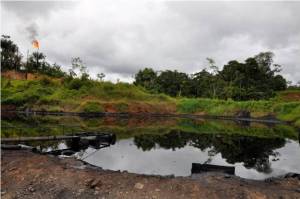
Open air and unlined ‘separating pools’ – May 2009
The United States is Ecuador’s principal market, 221,000 bbl/d that accounts for less than 2% of all U.S. oil imports. The remainder is divided between Latin America and Asia.
The government of President Correa appears to be redirecting oil policy in favour of Asian markets. An indicator would be the presumed $ 1 billion loan negotiated in April 2009, to be repaid exclusively in oil. The presence of Andes Petroleum, a consortium controlled by Chinese National Petroleum Corporation (CNCP), which took over Encana assets in the Amazon Rainforest, is further evidence of an increasing Chinese stake in Ecuadorian oil. Other foreign owned oil companies include Repsol-YPF, Parenco and Agip, which since 2007, through service agreements and fees, produce oil on behalf of the state.
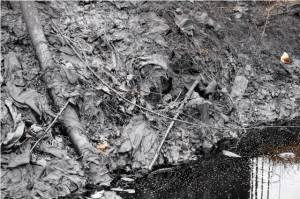
Toxic waste – May 2009
The Ecuadorian state owned Petroecuador accounts for 46% of crude oil production. Government control has implied a steady fall in productivity. For example in-between 2001-2005, when oil production increased by over 30%, Petroecuador’s share of national crude oil output dropped from 56% to 37%. The fall in production is the result of natural decline, a failure to reinvest and update infrastructure and technology, as is reflected by serious operating difficulties at existing oil fields.
OIL IN ECUADOR: THE DILEMMA
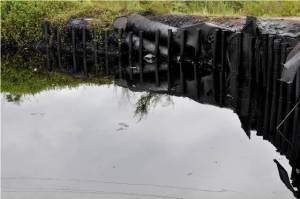
Discharge of toxic oil production waters into a neighboring creek – May 2009
From an economic perspective, insufficient refining capacity to satisfy the local market implies that the country has to import refined petroleum products. Subsequently export revenues are offset by refined oil imports. Venezuela and Ecuador have set up a joint company to resolve this problematic. The company plans to build a refinery in Manabi at a projected cost of $ 7 billion, and with an estimated capacity of 300,000 bbl/d.
Nevertheless the prices for heavy crude on the market shall always remain significantly lower than the cost of light product imports. The U.S. Energy Information Administration considers that this dichotomy implies that “the value of the net trade balance is more skewed than would be suggested by simply comparing import and export volumes. This can lead to situations where the country is unable to fully take advantage of higher world oil prices, because these higher prices might increase their product import bill by a greater amount than their crude oil export revenues.”
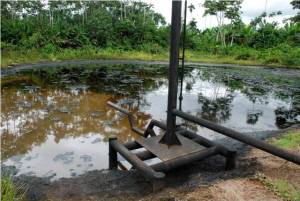
‘Separating pool’ and gas lift – May 2009
In our opinion, the real dilemma of oil in Ecuador lies in the fact that the most productive oil wells are located at the headwaters of the Amazon Rainforest and river basin. This region represents 30% of the earth’s biodiversity, nurtures an important source of 18% of our daily fresh water supply, and is home to an Ancestral Indigenous population whose existence and culture, is in direct contradiction with the rationality of oil production. If oil drilling in the Arctic reserve was rejected by environmentally conscious citizens, vetoed by the US Congress and Senate and totally opposed by President Barak Obama, then we, SELVA-Vida sin Fronteras, urgently request that international and national debate and action needs to focus on the universal implications of a similar process in the Amazon Rainforest.
Our request does not come in vain because the Ecuadorian State intends to increase future oil production by exploiting the Ishpingo-Tapococha-Tiputini (ITT) block, located in the heart the Yasuni National Park. The government of President Correa, contrary to the inalienable Rights of Nature recognized in the Ecuadorian Constitution -not to mention the intangible nature status of the Yasuni- plans to open ITT to oil investment in a near future. According to specialists the National Park “contains an estimated 900 million barrels of proven reserves, with potential recoverable reserves as high as 1.3 billion barrels. Analysts predict that, if fully developed, the block could produce at least 190,000 bbl/d.”
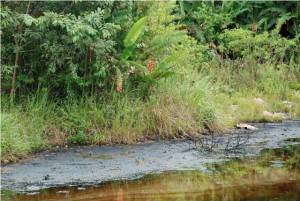
Flora severly affected by separating pool – May 2009
However, the crude oil in the Yasuni National Park is substantially heavier than the Napo variety. This implies that crude oil extracted in this particular region of the Amazon would have to be blended with highly toxic and environmentally disastrous lighter hydrocarbons, before it can be transported through any pipeline network.
We believe that the costs implicit in exploiting such a particularly heavy crude, have led President Correa to suggest to the international community that Ecuador be compensated $350 million per year, over a ten year period, to leave these Amazon oil reserves underground. Two questions immediately arise here.
The first: Will international diplomacy and law accept the concept of “Pay Me Not To Destroy Ecosystems Of Vital And Undeniable Universal Significance”? Should such a proposal be annexed to the ratified Universal Declaration of Human Rights and similar Conventions governing Environment and Nature Protection?
The second: Can poor and developing nations such as Ecuador resist increasing pressure from countries such as China to drill for oil in the Amazon Rainforest? What are the alternatives?
In order to place this discussion in perspective, we should consider the past and present impact of oil production in the Ecuadorian Amazon Rainforest.
THE PETROLEUM INDUSTRY IN THE ECUADORIAN AMAZON RAINFOREST
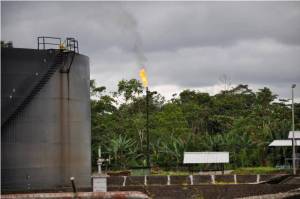
A crude reality – May 2009
Oil drilling and production in the Ecuadorian Amazon Rainforest is geographically located at the tributaries and headwaters of the Aguarico and Napo Rivers, upriver from the settlements of the Indigenous communities and the protected national parks. This implies that any oil spill, production discharge or other forms of contamination flows directly into the habitat of the communities.
Studies undertaken under the auspices of NRDC, suggest that each process of petroleum exploration and production in Ecuador has adverse consequence on the Rainforest and its inhabitants, starting from seismic studies and exploratory drilling up to production, transport and refining of crude oil.
Exploratory drilling generates significant quantities of toxic waste, which are deposited in open and unlined pools. The majority of the waste either filters through to underground water tables or spills over into streams and rivers. The remainder, approximately 42,000 gallons per exploratory well is burnt in the atmosphere, without temperature or pollution controls.
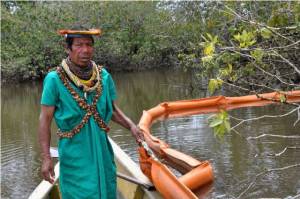
Siona Shaman inspecting poorly set up oil spill retention wall at the entry of the Laguna Grande in the Cuyabeno Nature Reserve – May 2009
Drilling mud mixed with chemical industrial solvents are components of toxic waste. An average of over 4,000 cubic meters of toxic wastes are drained into open pools every time an exploratory well is drilled. The environmental and health problems associated with exploratory drilling are repeated consistently during the production process. Separating stations generate more than 4 million gallons of untreated toxic wastes, which are discharged daily into the Rainforest.
Since 1972, we estimate 1 billion gallons of “toxic brine” – consisting of petroleum; formation water and chemicals injected into oil wells and utilized in the separation process of crude oil – are drained annually into rivers and ground soils of the Amazon region. The hydrocarbons and salts, components of the formation waters, are exceedingly toxic for vegetation, human and animal life. Texaco is directly responsible for approximately 19 billion gallons. An additional 16 billion gallons is attributable to Petroecuador.
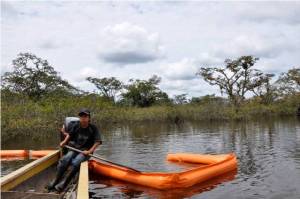
Oil spill retention wall obviously not retaining much at all – May 2009
Water tests confirm that the amount of salts present in Amazonian streams and rivers varies between 70,000 and 110,000 ppm, reaching 200,00 ppm near the major oil fields. This represents a level of salinity six times greater than ocean water. The same studies have also detected that the quantity of petroleum present in the principal tributaries varies between 500 to 5,000 ppm, an oil discharge of between 2,100 to 4,200 gallons of crude per day. Over the past 36 years, the oil industry has dumped 35 million barrels of crude into the Amazon basin. Furthermore 4 billion cubic feet of gas has been burnt without emission controls to avoid contamination of the atmosphere.
Oil spills in the Ecuadorian Amazon have been devastating. Official statistics released by Petroecuador indicate that 16.8 million gallons of oil were spilled between 1968-1993. During the period from 1993 to 2007, pipeline leakages, sabotage and accidental spillages accounted for an additional 7 million gallons.
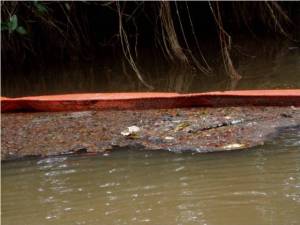
Crude oil up against the retention wall – May 2009
In conclusion, the Ecuadorian oil industry is accountable for 23.8 million gallons of crude polluting Amazonian rivers. The worst oil induced environmental disaster in history.
During the past years court cases have been brought against Texaco-Chevron for their undeniable role in this debacle. Nevertheless major oil contamination continues in an almost identical manner, although the actors and cast are different.
SELVA-Vida Sin Fronteras, jointly with the Ai’Cofan, Secoya and Siona communities, is setting up a comprehensive monitoring system of the oil industry. Our objective is to draw attention to present day reality, in the hope that the national and international community will consciously seek to remedy this oil induced environmental and human disaster, the implications of which are global.
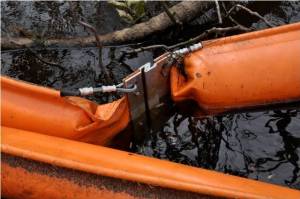
Public figures deny oil spills inside protected areas such as the Cuyabeno Nature Reserve – May 2009
